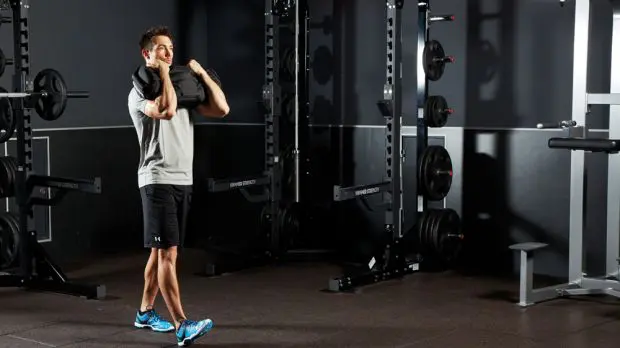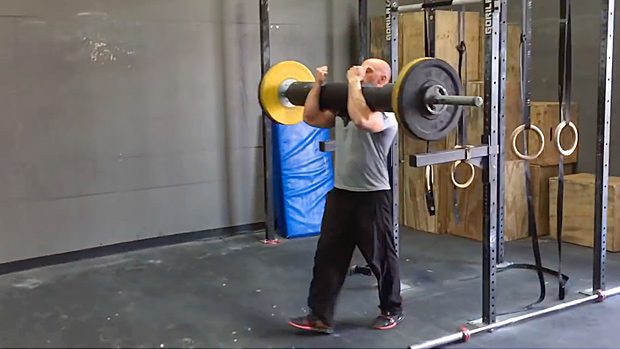
The best online fitness resource you'll ever need. We filter out the BS to ensure you meet your health and fitness goals!

The best online fitness resource you'll ever need. We filter out the BS to ensure you meet your health and fitness goals!

Some exercises have worthy but limited goals. Performing bicep curls will give you stronger arms and a more athletic looking physique. Calf raises lend some definition to your lower legs. However, neither of these has an amazing amount of carryover either to daily life or to most sporting endeavour.
Then there are exercises that absolutely do carry over into daily life and athletic ability, in magnificent style. The Zercher carry, as with most carries, is a prime example of this latter category. It improves your ability to maintain posture under load in general, and to carry something out in front of your body, thus in front of your centre of gravity, specifically.
If you ever pick up your children, carry a box hugged to your chest, lift shopping in and out of the boot of your car, carry a tray of food, or do anything else at all that involves bearing a weight in front of your body, the Zercher carry will make your life easier. As pretty much all of us perform this kind of motion pretty much daily, this applies very broadly indeed.
Furthermore, if your sport requires you to take resistance through the front of your body, especially a way outside of your centre of gravity, the Zercher carry will benefit you. Think Strongmen who have to perform plenty of front-loaded carries, Rugby and American Football players who need to manage tacklers and scrums, highlanders who need to control logs out in front as they toss the caber, Olympic- and powerlifters who manage heavy barbells out in front, both during training and in competition, shot-putters and other throwers who need to generate force out in front, and anyone else facing any amount of pressure in their frontal plane.

As a large compound movement, the Zercher carry works a lot of muscle fibre across a lot of different muscle groups. However, as with most carries (farmers carries, yoke walks and so on) it primarily focuses on your trunk (erector spinae, abdominals, obliques, hips and hip flexors etc). These all have to work hard during the carry to keep your torso upright and stable.
‘Zercher’ variations involve using the arms to move a weight in front of the body, held in the crooks of the elbows and/or across the forarms. Therefore, the Zercher carry also works your forearms, biceps and anterior delts, with the pecs and other delts engaging in a lesser way. The positioning also forces you to keep a strong, tensed and stable upper back, drawing the shoulder blades together and maintaining a neutral shoulder position with good form, working the upper portion of the lats, as well as the rhomboids.
Doing a basic Zercher carry is simple. However, this doesn’t mean that it’s easy – it’s one of the most taxing exercises going – and good form takes a little bit of practice.
In its basic form, to perform a Zercher carry:
This is the basic Zercher carry. It will do a lot for your strength and stability. However, there are some common mistakes and pitfalls to look out for, and a few details to bear in mind, in order to make the most out of it.
One of the more common mistakes is to treat the Zercher squat as almost a cardio movement, with a really long walk. This means either overdoing it, to the point at which you’ll likely drop the bar and have to start over, or going too light. Remember, it’s a strength movement. Start light, as you get used to it, before building up to a heavy weight. You shouldn’t really need to go over around 20 paces in each direction.
It’s also quite common to see people holding the bar too loosely, letting it sit passively in the elbows rather than holding onto it. The Zercher carry should be reasonably heavy and should represent a workout for your arms and shoulders – if you don’t want them to come into it, consider another carry. Hold the bar tight, squeezing it with your upper and lower arms, bringing it into the chest and keep your upper back engaged. It will allow you to bring more muscle into the movement and will give you far more control over the heavier weights involved.

Remember, too, that the bar should be in the crooks of your elbows, tight to your body. You shouldn’t be holding it in your hands. You won’t be able to hold onto enough weight to make it worthwhile as a carry if you do this. If you want to engage your biceps more or put your arms through some endurance work, consider pairing the Zercher carry with some bicep curl variations later in your workout.
Get these right, and load the bar up enough, and you will have one of the most potent trunk-building, stability-building exercises going. Every large movement will benefit – any compound that puts you under pressure, or any movement that involves front-loading, will improve if you include Zercher carries in your routines.